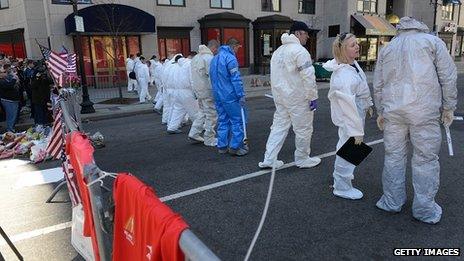Boston Marathon 'bombing suspect' seen on video
- Published

Officials investigating the Boston Marathon bombings say they have found images of a potential suspect from surveillance camera footage.
Boston City Council President Stephen Murphy said a man was seen dropping off a bag at the scene on Monday.
Earlier, the FBI denied reports that a suspect had been arrested.
Three people died in the twin blasts. President Obama is due to visit Boston on Thursday for a service honouring the victims.
More than 170 people were wounded and dozens remain in hospital, many of them seriously injured.
Mr Murphy said detectives had spotted the potential suspect in surveillance footage from a nearby store, AP news agency reported.
He said he didn't know if investigators had identified the man, but added: "They may be on the verge of arresting someone and that's good."
A planned FBI news conference outlining the progress of the investigation was postponed on Wednesday afternoon.
Earlier, police and journalists arrived at a courthouse in Boston amid confusion over whether a suspect had been held in connection with the attacks.
"Contrary to widespread reporting, there have been no arrests made in connection with the Boston marathon attack," the FBI said in a statement.
"Over the past day and a half, there have been a number of press reports based on information from unofficial sources that has been inaccurate."
Amputations
The Associated Press reported that the anonymous law enforcement official who was the news agency's source for the report that someone was in custody had insisted it was true, even as it was widely disputed.
President Barack Obama, who plans to attend an interfaith service on Thursday in honour of the victims in Boston, labelled the attack an act of terrorism.
Investigators have been sifting through thousands of pieces of evidence, ranging from video recorded on mobile phones to fragments of shrapnel removed from the victims' legs.
Maureen McGuire Dudley: 'It was just a horrific scene'
Officials said a circuit board and battery pack - parts of a triggering mechanism - had been recovered and the lid of a pressure cooker, apparently blown off during the explosion, was found on the roof of a nearby building.
The bombs are believed to have consisted of explosives placed in 1.6-gallon (6-litre) pressure cookers, one with shards of metal and ball bearings, the other with nails.
Nobody has claimed responsibility for the bombs, which a source said had been placed in black bags and left on the ground.
The twin blasts killed Martin Richard, eight, Krystle Campbell, 29, and Lu Lingzi, a postgraduate student from China.
Doctors treating the wounded say their injuries indicate that the bombs contained metal shards and other shrapnel. A number of victims have had limbs amputated.
Boston Medical Center trauma surgery chief Peter Burke said hospitals were saving "large quantities" of fragments extracted from victims for the police. They include metal, plastic, wood and concrete.
"We have a lot of lower extremity injuries, so I think the damage was low to the ground and wasn't up," Dr Burke said.
"The patients who do have head injuries were blown into things or were hit by fragments that went up."
At least 58 of the injured have been released from various hospitals around the city, according to AP.
Of those that remain, a five-year-old child, a nine-year-old girl and 10-year-old boy were among 17 victims listed as in a critical condition.
The first explosion went off close to the finish line at about 14:50 local time (18:50 GMT) on Monday.
Seconds later, as rescuers were rushing to help the injured, another explosion went off nearby.
The London Marathon - the next major international marathon - is to go ahead on Sunday, with police saying they have well-rehearsed security plans.
Organisers have said they will hold a 30-second silence at the start as a mark of respect.